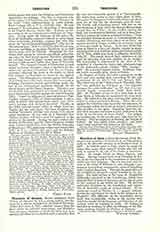

Theodore of Amasea, Saint, surnamed TYRO (TIRO) not because he was a young recruit, but because for a time he belonged to the Cohors Tyronum (Nilles, Kai. man., I, 105), called of Amasea from the place where he suffered martyrdom, and Euchaita from the place, Euchais, to which his body had been carried, and where he was held in such veneration thatthe city was frequently spoken of as Theodoropolis. His martyrdom seems to have taken place February 17, 306, under the Emperors Galerius Maximian and Maximin, for on this day the Menologies give his feast. The Greeks and Armenians honor him also on the first Saturday of Lent, while the Roman Martyrology records him on November 9 In the twelfth century his body was transferred to Brindisi, and he is there honored as patron; his head is enshrined at Gaeta. There are churches bearing his name at Constantinople, Jerusalem, Damascus, and other places of the East. An ancient church of Venice, of which he is titular, is said to have been built by Narses. At the foot of the Palatine in Rome is a very old church, circular in shape and dedicated to S. Teodoro, whom the Roman people call S. Toto, which was made a collegiate church by Felix IV. The people showed their confidence in the saint by bringing their sick children to his temple. His martyrdom is represented in the choir of the cathedral of Chartres by thirty-eight glass paintings of the thirteenth century (Migne, “Dict. iconogr.”, 599). He is invoked against storms. Emblems: temple, torch, crocodile, pyre, crown of thorns.
St. Gregory of Nyasa delivered a panegyric on his feast and gave several data concerning his life and martyrdom (P.G., XLVI, 741, and Ruinart, 505). The oldest text of the “Martyrium S. Theodori Tironis” was published by Delehaye in “Les legendes grecques des saints militaires”, p. 227, but it is considered largely interpolated (Anal. Boll., XXX, 323). St. Theodore is said to have been born in the East (Syria or Armenia are mentioned by some writers). He enlisted in the army and was sent with his cohort to winter quarters in Pontus. When the edict against the Christians was issued by the emperors, he was brought before the Court at Amasea and asked to offer sacrifice to the gods. Theodore, however, denied their existence and made a noble profession of his belief in the Divinity of Jesus Christ. The judges, pretending pity for his youth, gave him time for reflection. This he employed in burning the Temple of Cybele. He was again taken prisoner, and after many cruel torments was burned at the stake.
FRANCIS MERSHMAN

